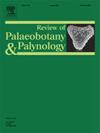德克萨斯州中北部的两个早二叠世植物化石组合及其与该地区其他二叠世沉积物的比较
IF 1.7
3区 地球科学
Q2 PALEONTOLOGY
引用次数: 0
摘要
德克萨斯州中北部保存了早二叠纪的植物区系变化记录,从亚塞利亚到昆古里亚。在这段时间内出现的区域植物区系在组成上以系统的方式变化,并表明了环境变化的主要时期。在这里,我们描述了两个来自Artinskian晚期的这样的植物群,它们在地理和地层上都很接近,后者(1991年)最初被认为来自于同一地点,但后来被证明来自于同一地区的不同层。对“农民池”和“牛池”两种植物区系进行了定量分析。它们由相同的基本混合分类群组成,但具有显著不同的优势-多样性特征;农民池以瓦尔阡针叶树为主,次优势为阔叶树蕨和巨翼蕨,牛池以阔叶树蕨为主,次优势为阔叶树蕨和大翼蕨,第4位为针叶树。这些植物群来自于区域植物群变化的早期阶段,从大量以针叶树和其他旱生耐旱植物为主,到富含甚至以蕨类植物为主的“混合”植物群,但保留了耐旱植物的主要成分。这些数量上的差异可能反映了沉积环境的差异,但也可能反映了一年中的季节差异——农民池收集的种子种类丰富(13种形态),而牛池收集的种子很少。这些植物区系特征强烈表明,这是一个季节性气候条件下的景观,有一段时间的水分不足。本文章由计算机程序翻译,如有差异,请以英文原文为准。
Two plant-fossil assemblages of early Permian age from north-central Texas and their comparison with other Permian deposits of the region
North-Central Texas preserves an early Permian record of floristic change from the Asselian through the Kungurian. The regional floras that occur during that time interval vary compositionally in systematic ways and indicate major periods of environmental change. Here we describe two such floras from the late Artinskian, found in close geographic and stratigraphic proximity, the latter collection (1991) initially was thought to be from the same site as an earlier collection (1974), but proved to be from a different layer in the same area. The two floras, “Farmer's Tank” and “Cattle Tank” were analyzed quantitatively. They are composed of the same basic mixture of taxa but with strikingly different dominance-diversity profiles; Farmer's Tank is dominated by walchian conifers with subdominant marattialean tree ferns and gigantopterids, and Cattle Tank by marattialean tree ferns with subdominant noeggerathialeans and callipterids with conifers fourth in rank. These floras are from the early phases of a change in regional floras from heavily dominated by conifers and other xeromorphic, drought-tolerant elements, to “mixed” floras rich in, even dominated by marattialean tree ferns, but retaining a major component of drought-tolerant elements. These quantitative differences may reflect differences in the environment of deposition, but also possibly in season of the year - the Farmer's Tank collection is rich in seeds of considerable variety (13 morphotypes), whereas the Cattle Tank collection contains few seeds. These floristic features strongly suggest a landscape under seasonal climatic conditions with a period of moisture deficit.
求助全文
通过发布文献求助,成功后即可免费获取论文全文。
去求助
来源期刊
CiteScore
3.50
自引率
21.10%
发文量
149
审稿时长
6 months
期刊介绍:
The Review of Palaeobotany and Palynology is an international journal for articles in all fields of palaeobotany and palynology dealing with all groups, ranging from marine palynomorphs to higher land plants. Original contributions and comprehensive review papers should appeal to an international audience. Typical topics include but are not restricted to systematics, evolution, palaeobiology, palaeoecology, biostratigraphy, biochronology, palaeoclimatology, paleogeography, taphonomy, palaeoenvironmental reconstructions, vegetation history, and practical applications of palaeobotany and palynology, e.g. in coal and petroleum geology and archaeology. The journal especially encourages the publication of articles in which palaeobotany and palynology are applied for solving fundamental geological and biological problems as well as innovative and interdisciplinary approaches.

 求助内容:
求助内容: 应助结果提醒方式:
应助结果提醒方式:


